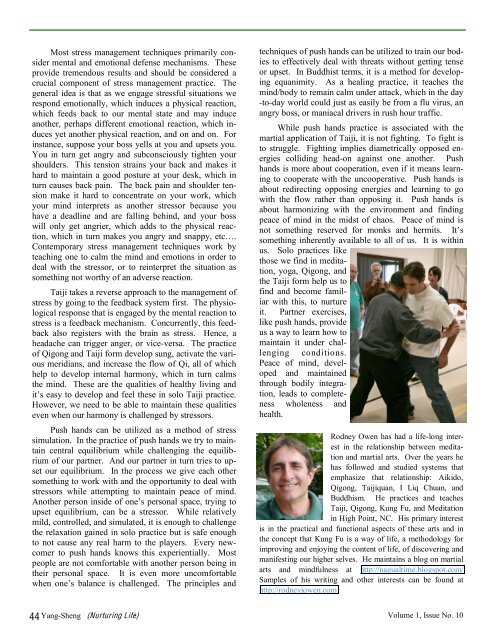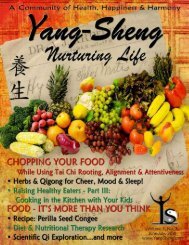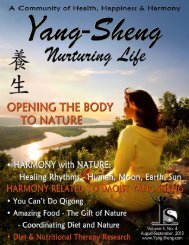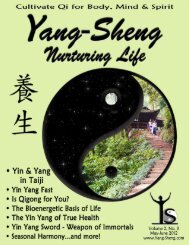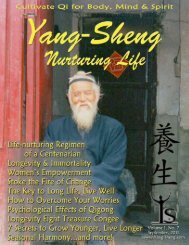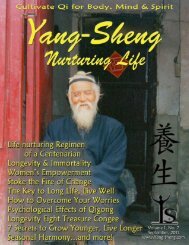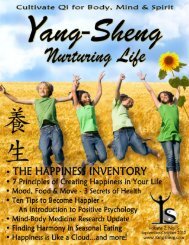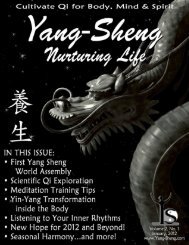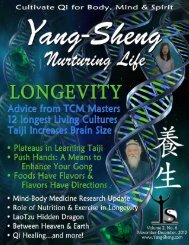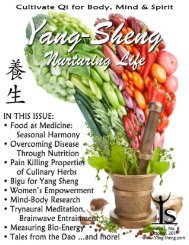Download the December issue of Yang-Sheng as
Download the December issue of Yang-Sheng as
Download the December issue of Yang-Sheng as
You also want an ePaper? Increase the reach of your titles
YUMPU automatically turns print PDFs into web optimized ePapers that Google loves.
Most stress management techniques primarily consider<br />
mental and emotional defense mechanisms. These<br />
provide tremendous results and should be considered a<br />
crucial component <strong>of</strong> stress management practice. The<br />
general idea is that <strong>as</strong> we engage stressful situations we<br />
respond emotionally, which induces a physical reaction,<br />
which feeds back to our mental state and may induce<br />
ano<strong>the</strong>r, perhaps different emotional reaction, which induces<br />
yet ano<strong>the</strong>r physical reaction, and on and on. For<br />
instance, suppose your boss yells at you and upsets you.<br />
You in turn get angry and subconsciously tighten your<br />
shoulders. This tension strains your back and makes it<br />
hard to maintain a good posture at your desk, which in<br />
turn causes back pain. The back pain and shoulder tension<br />
make it hard to concentrate on your work, which<br />
your mind interprets <strong>as</strong> ano<strong>the</strong>r stressor because you<br />
have a deadline and are falling behind, and your boss<br />
will only get angrier, which adds to <strong>the</strong> physical reaction,<br />
which in turn makes you angry and snappy, etc….<br />
Contemporary stress management techniques work by<br />
teaching one to calm <strong>the</strong> mind and emotions in order to<br />
deal with <strong>the</strong> stressor, or to reinterpret <strong>the</strong> situation <strong>as</strong><br />
something not worthy <strong>of</strong> an adverse reaction.<br />
Taiji takes a reverse approach to <strong>the</strong> management <strong>of</strong><br />
stress by going to <strong>the</strong> feedback system first. The physiological<br />
response that is engaged by <strong>the</strong> mental reaction to<br />
stress is a feedback mechanism. Concurrently, this feedback<br />
also registers with <strong>the</strong> brain <strong>as</strong> stress. Hence, a<br />
headache can trigger anger, or vice-versa. The practice<br />
<strong>of</strong> Qigong and Taiji form develop sung, activate <strong>the</strong> various<br />
meridians, and incre<strong>as</strong>e <strong>the</strong> flow <strong>of</strong> Qi, all <strong>of</strong> which<br />
help to develop internal harmony, which in turn calms<br />
<strong>the</strong> mind. These are <strong>the</strong> qualities <strong>of</strong> healthy living and<br />
it’s e<strong>as</strong>y to develop and feel <strong>the</strong>se in solo Taiji practice.<br />
However, we need to be able to maintain <strong>the</strong>se qualities<br />
even when our harmony is challenged by stressors.<br />
Push hands can be utilized <strong>as</strong> a method <strong>of</strong> stress<br />
simulation. In <strong>the</strong> practice <strong>of</strong> push hands we try to maintain<br />
central equilibrium while challenging <strong>the</strong> equilibrium<br />
<strong>of</strong> our partner. And our partner in turn tries to upset<br />
our equilibrium. In <strong>the</strong> process we give each o<strong>the</strong>r<br />
something to work with and <strong>the</strong> opportunity to deal with<br />
stressors while attempting to maintain peace <strong>of</strong> mind.<br />
Ano<strong>the</strong>r person inside <strong>of</strong> one’s personal space, trying to<br />
upset equilibrium, can be a stressor. While relatively<br />
mild, controlled, and simulated, it is enough to challenge<br />
<strong>the</strong> relaxation gained in solo practice but is safe enough<br />
to not cause any real harm to <strong>the</strong> players. Every newcomer<br />
to push hands knows this experientially. Most<br />
people are not comfortable with ano<strong>the</strong>r person being in<br />
<strong>the</strong>ir personal space. It is even more uncomfortable<br />
when one’s balance is challenged. The principles and<br />
techniques <strong>of</strong> push hands can be utilized to train our bodies<br />
to effectively deal with threats without getting tense<br />
or upset. In Buddhist terms, it is a method for developing<br />
equanimity. As a healing practice, it teaches <strong>the</strong><br />
mind/body to remain calm under attack, which in <strong>the</strong> day<br />
-to-day world could just <strong>as</strong> e<strong>as</strong>ily be from a flu virus, an<br />
angry boss, or maniacal drivers in rush hour traffic.<br />
While push hands practice is <strong>as</strong>sociated with <strong>the</strong><br />
martial application <strong>of</strong> Taiji, it is not fighting. To fight is<br />
to struggle. Fighting implies diametrically opposed energies<br />
colliding head-on against one ano<strong>the</strong>r. Push<br />
hands is more about cooperation, even if it means learning<br />
to cooperate with <strong>the</strong> uncooperative. Push hands is<br />
about redirecting opposing energies and learning to go<br />
with <strong>the</strong> flow ra<strong>the</strong>r than opposing it. Push hands is<br />
about harmonizing with <strong>the</strong> environment and finding<br />
peace <strong>of</strong> mind in <strong>the</strong> midst <strong>of</strong> chaos. Peace <strong>of</strong> mind is<br />
not something reserved for monks and hermits. It’s<br />
something inherently available to all <strong>of</strong> us. It is within<br />
us. Solo practices like<br />
those we find in meditation,<br />
yoga, Qigong, and<br />
<strong>the</strong> Taiji form help us to<br />
find and become familiar<br />
with this, to nurture<br />
it. Partner exercises,<br />
like push hands, provide<br />
us a way to learn how to<br />
maintain it under challenging<br />
conditions.<br />
Peace <strong>of</strong> mind, developed<br />
and maintained<br />
through bodily integration,<br />
leads to completeness<br />
wholeness and<br />
health.<br />
Rodney Owen h<strong>as</strong> had a life-long interest<br />
in <strong>the</strong> relationship between meditation<br />
and martial arts. Over <strong>the</strong> years he<br />
h<strong>as</strong> followed and studied systems that<br />
emph<strong>as</strong>ize that relationship: Aikido,<br />
Qigong, Taijiquan, I Liq Chuan, and<br />
Buddhism. He practices and teaches<br />
Taiji, Qigong, Kung Fu, and Meditation<br />
in High Point, NC. His primary interest<br />
is in <strong>the</strong> practical and functional <strong>as</strong>pects <strong>of</strong> <strong>the</strong>se arts and in<br />
<strong>the</strong> concept that Kung Fu is a way <strong>of</strong> life, a methodology for<br />
improving and enjoying <strong>the</strong> content <strong>of</strong> life, <strong>of</strong> discovering and<br />
manifesting our higher selves. He maintains a blog on martial<br />
arts and mindfulness at http://nagualtime.blogspot.com/<br />
Samples <strong>of</strong> his writing and o<strong>the</strong>r interests can be found at<br />
http://rodneyjowen.com<br />
44 <strong>Yang</strong>-<strong>Sheng</strong> (Nurturing Life) Volume 1, Issue No. 10


